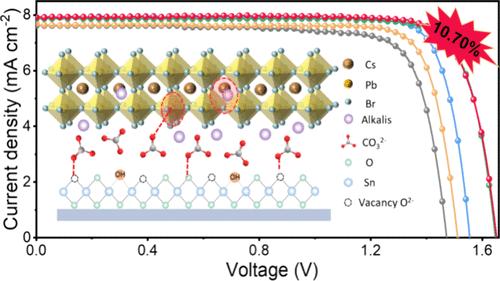碱金属碳酸盐对高效全无机钙钛矿太阳能电池埋藏界面的精炼
IF 8.2
2区 材料科学
Q1 MATERIALS SCIENCE, MULTIDISCIPLINARY
引用次数: 0
摘要
埋藏界面对钙钛矿太阳能电池(PSCs)的效率和稳定性起着至关重要的作用。然而,SnO2/钙钛矿界面处的缺陷状态和能级错位会导致显著的电荷复合,严重限制器件性能。本文介绍了基于碱金属碳酸盐的碳基CsPbBr3聚酰亚胺多功能界面改性剂。CO32 -阴离子不仅钝化了SnO2表面的氧空位(OV)缺陷和欠配位的Sn4+离子,增强了电子转移,而且钝化了钙钛矿界面处的欠配位Pb2+离子,提高了钙钛矿膜的整体质量。此外,碱离子扩散到钙钛矿体中,提高了晶体质量,抑制了非辐射复合。通过利用这种多面接口工程方法,冠军CsPbBr3 PSC实现了令人印象深刻的10.70%的PCE。重要的是,未封装的设备在高湿(85% RH)和高温(85°C)下保持85%的初始效率超过50天。本文章由计算机程序翻译,如有差异,请以英文原文为准。

Refining the Buried Interface via Alkali Metal Carbonate for Efficient All-Inorganic Perovskite Solar Cells
The buried interface plays a critical role in determining both the efficiency and stability of perovskite solar cells (PSCs). However, defect states and energy level misalignment at the SnO2/perovskite interface can lead to significant charge recombination, severely limiting device performance. Herein, multifunctional interface modifiers based on alkali metal carbonates are introduced for carbon-based CsPbBr3 PSCs. The CO32– anions not only passivate oxygen vacancy (OV) defects and undercoordinated Sn4+ ions on the SnO2 surface to enhance electron transfer but also passivate undercoordinated Pb2+ ions at the perovskite interface, improving the overall quality of the perovskite film. Additionally, the alkali cations were found to diffuse into the perovskite bulk, enhancing crystal quality and suppressing nonradiative recombination. By leveraging this multifaceted interface engineering approach, a champion CsPbBr3 PSC achieved an impressive PCE of 10.70%. Importantly, the unencapsulated devices maintain 85% of initial efficiency under high humidity (85% RH) and heat (85 °C) over 50 days.
求助全文
通过发布文献求助,成功后即可免费获取论文全文。
去求助
来源期刊

ACS Applied Materials & Interfaces
工程技术-材料科学:综合
CiteScore
16.00
自引率
6.30%
发文量
4978
审稿时长
1.8 months
期刊介绍:
ACS Applied Materials & Interfaces is a leading interdisciplinary journal that brings together chemists, engineers, physicists, and biologists to explore the development and utilization of newly-discovered materials and interfacial processes for specific applications. Our journal has experienced remarkable growth since its establishment in 2009, both in terms of the number of articles published and the impact of the research showcased. We are proud to foster a truly global community, with the majority of published articles originating from outside the United States, reflecting the rapid growth of applied research worldwide.
 求助内容:
求助内容: 应助结果提醒方式:
应助结果提醒方式:


